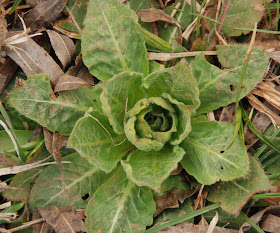If you want lush photos of beautiful spring plants in March, don't look to the prairie.
Here are my lush, spring plants. Note: they are daffodils...and they are not native. On the plus side, last weekend's snow didn't phase them in the least. These weren't in bloom yet when the snow hit, but the buds were ready to go. The snow melted. We got one day of 60+ degree temperatures...and voila!
This little cluster is Tete-a-Tete.
On the prairie, the plants are much wiser. Few are really greening up yet, although basal rosettes that have been visible all winter are beginning to wake up, shrug a little, and start to think about putting on some growth.
These ruffly, little, gray-green cuties are young wavy-leaf thistle (Cirsium undulatum), ready for the magic of spring to call them skyward. One of the native prairie thistles, wavy-leaf is easy to identify by the namesake curling edges of its leaves and by their attractive color. It is not invasive.
Another easy-to-identify basal rosette belongs to yarrow (Achillea millefolium). I love the delicate looking (but tough as nails), ferny leaves that somehow manage to survive everything that winter throws at them. By the way, I apologize for the distracting bisection of the photo: a perfect example of my mind erasing something mentally as I took the picture. The camera lens, unfortunately, doesn't perform the same function!
When we first moved out here to Patchwork Prairie, I noticed these basal rosettes in winter and thought that I was seeing black-eyed Susans...just a bit hairier than normal. As spring progressed, it was obvious that this wasn't, in fact, a Rudbeckia of any sort; I eventually learned to identify it as hairy hawkweed (Hieracium longipilum). Now, of course, I can't believe I ever mistook the two!
Despite its unique leaves, to my eyes the flowers of hairy hawkweed are rather blah - a very open cluster of small, yellow, daisy-like blooms held high above the plant on a thin stem. Truthfully, those leaves are much more interesting! I've even found myself mistaking the winter rosettes for dead animal carcases. I'm not sure what benefit that resemblance would give them, but surely there's some sort of positive gain for the plant there.
Speaking of blah, I think that these little, rather nondescript, green rosettes ARE actually black-eyed Susans (Rudbeckia hirta). Note last year's seedhead on the ground in front of the rosette at the bottom....
The last winter rosette that I will share from this morning's walkabout is, I think, velvety gaura (Gaura mollis). It's quite attractive, bearing a striking resemblance to a small, green, cabbage rose. I've qualified my identification, though, since the leaves don't have quite the same velvety feel that later leaves will have. I haven't watched this plant grow from early spring on, so I'm a bit more tentative here.
In the draw, a few other plants - native plants - are beginning to put forth tiny leaves: the clove currant, for example, and the eastern wahoo. None of them, however, are really getting exuberant yet. The prairie doesn't encourage early spring exuberance. There's time for that when spring is a little more advanced...and certain.







I love the first little bits of a plant that pokes up out of the ground in the Spring.
ReplyDeleteYou should link this post up with Gail at Clay and Limestone for her Wildflower Wednesday meme. It is the 4th Wednesday of each month. Her blog is clayandlimestone dot com.
Have a blessed week-end!
Lea
Lea's Menagerie
Thanks for stopping by, Lea!
ReplyDeleteThanks for showing what these plants look like when they start in the spring. I have the yarrow in my garden. Looks like it's coming on strong again.
ReplyDelete